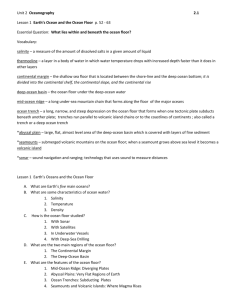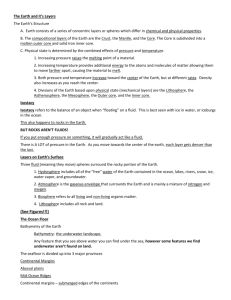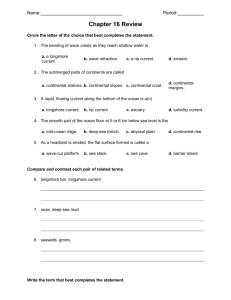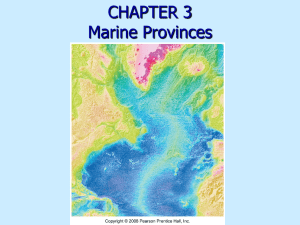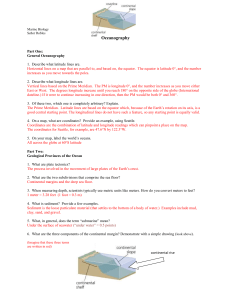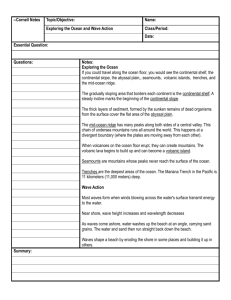deep-ocean basin features
advertisement
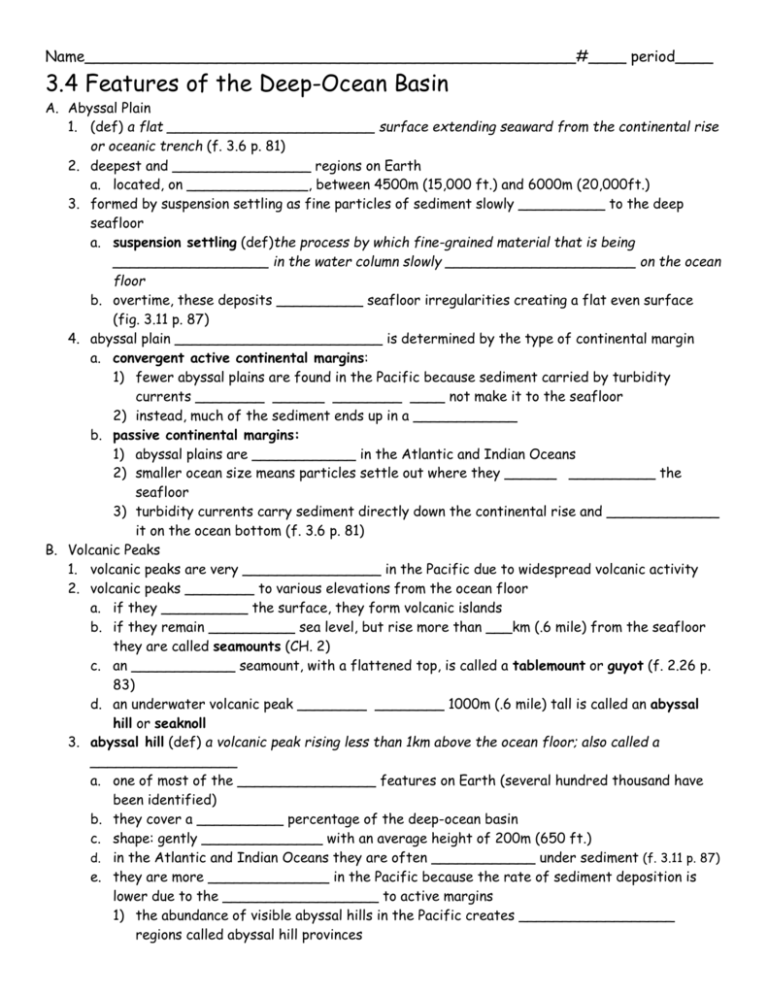
Name____________________________________________________#____ period____ 3.4 Features of the Deep-Ocean Basin A. Abyssal Plain 1. (def) a flat ________________________ surface extending seaward from the continental rise or oceanic trench (f. 3.6 p. 81) 2. deepest and ________________ regions on Earth a. located, on ______________, between 4500m (15,000 ft.) and 6000m (20,000ft.) 3. formed by suspension settling as fine particles of sediment slowly __________ to the deep seafloor a. suspension settling (def)the process by which fine-grained material that is being __________________ in the water column slowly ______________________ on the ocean floor b. overtime, these deposits __________ seafloor irregularities creating a flat even surface (fig. 3.11 p. 87) 4. abyssal plain ________________________ is determined by the type of continental margin a. convergent active continental margins: 1) fewer abyssal plains are found in the Pacific because sediment carried by turbidity currents ________ ______ ________ ____ not make it to the seafloor 2) instead, much of the sediment ends up in a ____________ b. passive continental margins: 1) abyssal plains are ____________ in the Atlantic and Indian Oceans 2) smaller ocean size means particles settle out where they ______ __________ the seafloor 3) turbidity currents carry sediment directly down the continental rise and _____________ it on the ocean bottom (f. 3.6 p. 81) B. Volcanic Peaks 1. volcanic peaks are very ________________ in the Pacific due to widespread volcanic activity 2. volcanic peaks ________ to various elevations from the ocean floor a. if they __________ the surface, they form volcanic islands b. if they remain __________ sea level, but rise more than ___km (.6 mile) from the seafloor they are called seamounts (CH. 2) c. an ____________ seamount, with a flattened top, is called a tablemount or guyot (f. 2.26 p. 83) d. an underwater volcanic peak ________ ________ 1000m (.6 mile) tall is called an abyssal hill or seaknoll 3. abyssal hill (def) a volcanic peak rising less than 1km above the ocean floor; also called a _________________ a. one of most of the ________________ features on Earth (several hundred thousand have been identified) b. they cover a __________ percentage of the deep-ocean basin c. shape: gently ______________ with an average height of 200m (650 ft.) d. in the Atlantic and Indian Oceans they are often ____________ under sediment (f. 3.11 p. 87) e. they are more ______________ in the Pacific because the rate of sediment deposition is lower due to the __________________ to active margins 1) the abundance of visible abyssal hills in the Pacific creates __________________ regions called abyssal hill provinces 2) abyssal hill province (def) a deep-sea region where sediment rates are so ______ that abyssal plains do not develop, instead the area is covered with abyssal hills C. Ocean Trenches and Volcanic Arcs 1. passive continental margins end in a continental rise that merges _________________ into the deep-ocean abyssal plain 2. convergent active continental margins ______________ into an ocean trench, there is no continental rise 3. ocean trench (def) deep linear scars in the ocean floor caused by the __________________ of two plates at a subduction zone a. the ________________ side of the trench rises as a volcanic arc b. examples: 1) the islands of Japan (an example of an island arc) 2) the Andes Mountains (an example of a continental arc) c. the ______________ portions of the ocean are located in trenches (see Table 3.2 page 90) d. the majority of ocean trenches are found along the ______________ of the Pacific Ocean D. The Pacific Ring of Fire 1. Pacific Ring of Fire (def) an extensive zone of volcanic and seismic activity that coincides roughly with the ______________ of the Pacific Ocean (Pacific Rim) 2. exhibits widespread volcanic and seismic activity due to the prevalence of _________________ boundaries along the Pacific Rim a. contains the majority of Earth’s ____________ volcanoes b. is the location of the ________________ of Earth’s large earthquakes 3. a tremendous amount of ____________ is shown along the “Ring” where deep-see trenches at convergent boundaries are associated with tall volcanic arcs a. example: Peru-Chile Trench/Andes Mountain system (see fig. 3.13 p. 91) Directions: Draw the indicated above each label. Your drawing should indicate the appropriate height and shape of each feature (use the depth measurements on the left as a reference). sea level _______________________________________________________________________ 1000 m (1km) ___ 500 m sea floor ___
